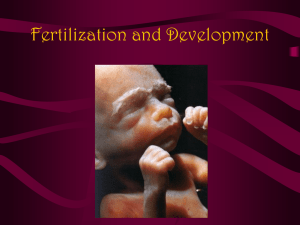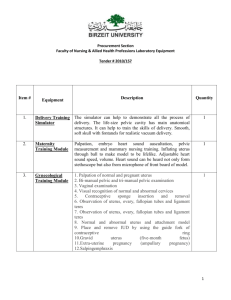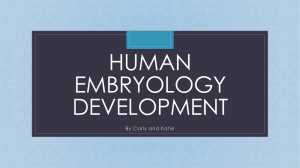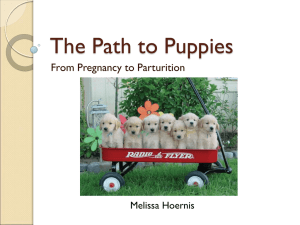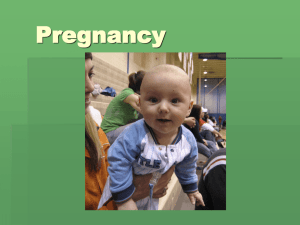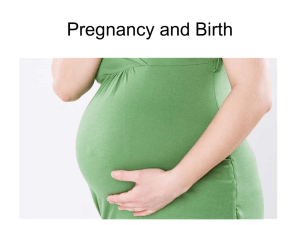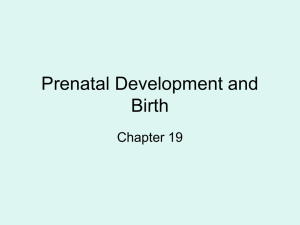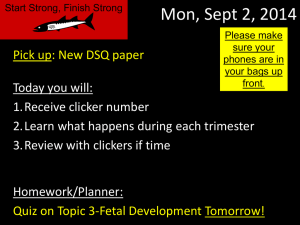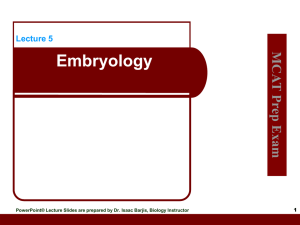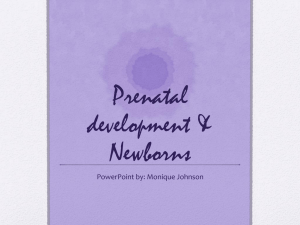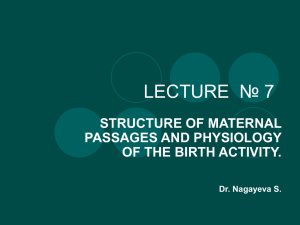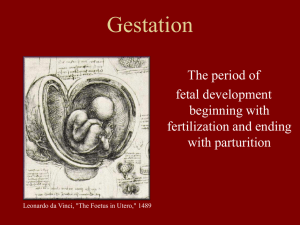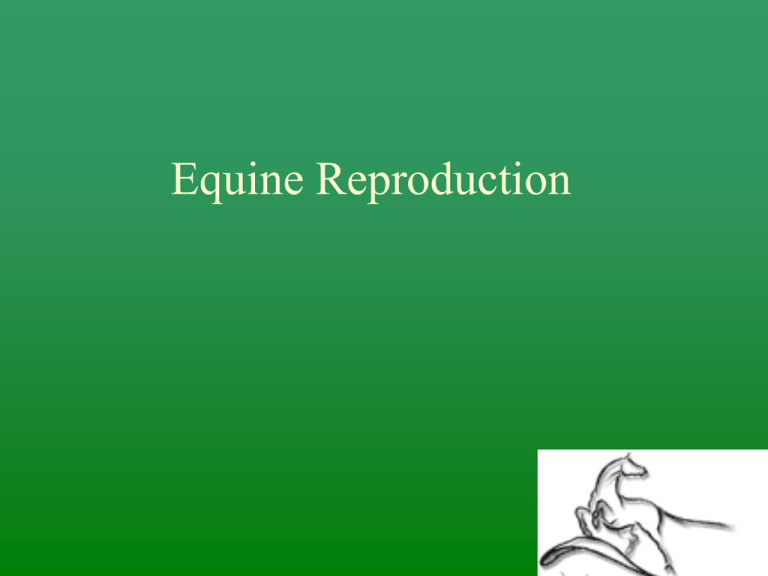
Equine Reproduction
Definitions
• Gestation: time of pregnancy.
– Range 310-370 days
• Parturition: Birthing process
• Fertilization: when the egg meets the sperm
and the zygote is formed.
• Implantation: When the egg attaches to the
wall of the uterine horn to get food
The Mare’s Reproductive System
Mares have complicated reproductive
processes, and they do not easily become
pregnant.
Each mare has her own reproductive
pattern, and knowing that pattern is the
key to increasing the chances of
fertilization.
Female Anatomy
•
Ovary: the main organ of reproduction.
– kidney-shaped organs that produce hormones
and the ova (eggs).
– The ovaries are small and hard while inactive.
• Oviduct: a tube from the ovaries to the uterine
horn.
– When the egg reaches the oviduct it can be
fertilized by sperm cells if they are present
• Fimbria:(infundibulum)funnel shaped end
of the oviduct near the ovary; catches the
egg and funnels it into the oviduct.
Female (dam) Anatomy
• Uterine Horns: area between the oviduct and the
uterus.
– Where implantation of the egg occurs
• Uterus : area between the horns and the cervix
– lined with the placenta that the growing fetus fills
• Cervix: Tightly knotted muscle that regulates what
enters or leaves the uterus
– Dialates during parturition
Female Anatomy
• Vagina: area between the cervix and the
vulva
– Birth canal
• Vulva: opening to the outside world
• Clitoris: sensory organ
Female ReproductiveTract
Equine Reproduction
Male (sire) Anatomy
1. Testes:
– Site of sperm production; produce the male hormone
testosterone.
2. Scrotum:
• Protective sack around the testes; helps to regulate
the temperature of the testes. The cremaster muscle
contracts to draw the testes up toward the body
during cold weather to keep them
warm, and relaxes to lower them away
from the body to keep them cool when
the weather is hot.
Stallion
3. Epididymis:
• The site of sperm storage and maturation.
Stallion parts
• 4. Vas deferens:
–The passageway for the sperm to
pass from the epididymis to the
urethra and accessory sex glands
in the pelvic region.
• 5. Penis:
–The copulatory organ
of the stallion.
Stallion Parts
• 6. Prepuce:
– Loose surrounding skin that protects
the free end of the penis.
• 7. Accessory sex glands:
– Contribute fluids that serve as a buffer
and source of nutrients for the sperm
cells: bulbourethral gland, prostate
gland, vesicular gland.
Stallion
Stallion
• Libido stands for: Sex drive of a
stallion
• Spermatozoa mature in the
epididymis
(GnRH)
• gonadotropin releasing hormone
• GnRH stimulates the secretion of
the gonadotropins, follicle
stimulating hormone (FSH) and
luteinizing hormone (LH)
• FSH and LH stimulate the ovaries
Gestation period Length - Horses
• Range
310-370 days
• Average 336 days
Progesterone
• Hormone produced at the uterus to maintain
the pregnancy.
Gestation period length
• Knowledge of the length of gestation period
is important to the producer because:
a. it helps to regulate production cycles
b. it helps in the planning of the breeding
program
c. it helps to predict the date of birth
Abortion • EXPULSION of the fetus before the time of
PARTURITION.
Causes for abortions:
• 1. Infections
a. Bacteria and Fungi (ex.,
Rhinopneumonitis, Vibriosis)
b. Viral (ex., influenza)
c. Protozoans (ex., Trichomoniasis)
Causes for abortions:
• 2. Genetic Abortions
a. Occur when the fetus is malformed
b. Dam's body usually rejects the
malformed fetus for reasons unknown.
Causes for abortions:
• 3. Injury related abortions
a. Rare because fetus is well protected
b. Prevent injuries caused by kicking,
bumping, or squeezing
Causes for abortions:
• 4. Nutrition
Examples:
- Poisonous Plants
- Ration too low in required nutrients
Development
• 3 periods of development from pregnancy
to birth
- Ovum Period
- Embryonic Period
- Fetal Period
Ovum Period ( Days 0 to 25 in
horses)
• 1. Fertilization
• 2. Cell Division
Stages during the ovum period
• Zygote – 2 to 8 cells
Stages during the ovum period
• Zygote – 2 to 8 cells
• Morula – spherical mass of cells (outer
layer and central core)
Stages during the ovum period
• Zygote – 2 to 8 cells
• Morula – spherical mass of cells (outer
layer and central core)
• Blastula -- mass of cells with a hollow
cavity
Embryo Period (Days 25 to 60 in
horses)
• 3. Implantation - the new embryo becomes
implanted in the uterine horn where it will
be nourished and develop.
Abnormal implantation
• Ovarian: Young seldom survive to full term
• Tubal: Young rarely survive to birth
• Abdominal: Young do not survive to full
term
Embryo Period
• 4. Differentiation - cells become organized
into specific structures
Embryo Period
• 5. Completion of all major ORGAN
systems.
Embryo Period
• 6. Looks like the ORGANISM.
Fetal Period (Days 60 to 336 in
horses)
• 7. Placentation - MEMBRANES develop to
provide the FETUS with NUTRITION.
• Each embryo usually has their own set of
membranes
Placental Structures:
• Amnion – inner most layer that forms a sac
around the embryo/fetus. (Amniotic Sac)
• Filled with amniotic fluid that protects
young from shock and adhesion
Types of placental attachment
• Diffuse – contact is made over most of
the uterus
• Mares, sows, humans
Placental Structures
• Umbilical Cord - long FLEXIBLE tube
attached to the placenta where FOOD,
OXYGEN, and WASTES are exchanged
between the MOTHER and the baby.
Placental Barrier
• Placenta prevents large molecules from
passing from mother to young.
• Viruses are small enough to penetrate as are
certain other chemicals.
Fetal Period
• 8. Growth and Development - the fetus
GROWS and organs continue to DEVELOP
so that the animal can LIVE on its OWN.
Parturition -the act of giving birth
Signs of birth in horses
1. 2-6 weeks prior, udder swells
2. 7-10 days prior, muscles shrink and
abdomen drops
3. 4-6 days prior, teats fill with milk
4. 12-24 hours prior, “wax” appears on
nipples (“waxing”)
Stages of Parturition (Labor)
• Stage 1 - Preparatory Stage
• Stage 2 - Expulsion of fetus
• Stage 3 - Expulsion of the
placenta
• Stage 4 -Period of Rest
Preparatory Stage
1. Restlessness of animal due to
minor contractions
2. Dilation of the cervix
3. Cervix expands allowing
uterus and vagina to
become a continuous
canal
Expulsion of the fetus
1. Increased contraction (abdominal
pressing marks)
2. Straining followed by a few
minutes of rest
3. Fetus enclosed in amnion,
propelled through birth
canal and appears at vulva
Expulsion of the fetus
5. In horses, placental connections
are broken. 2nd stage must be rapid
Expulsion of placenta (afterbirth)
1. Caused by uterine contractions
2. Placenta should be expelled
within 12 hours following
parturition
Expulsion of placenta (afterbirth)
(foaling problems, abortion,
twins, etc., may cause it to be
retained)
3. Used to remove retained
placenta by hand, now we treat
it with antibiotics.
Stage 4
• Period of Rest
Proper Presentation
• Most common is forelegs first with
nose resting on the forelegs
(anterior)
• Mild labor pains usually start
several hours before actual birth
Proper Presentation
Head and Hind legs Forward
Neck Presented
Proper Presentation
• First water bag will appear on the
outside increasing in size until it
ruptures due to its own weight
• Immediately after the first bag, the
amniotic bladder (second water
bag) follows, containing the fetus
Proper Presentation
• Presentation of fetus after straining
on the mares part
• If presentation is normal and
within 45 minutes to an hour hours
after the first signs of foaling, then
no assistance is necessary
• Always treat the umbilical cord
with iodine after birth
Dystocia
• Difficulty during
parturition
Fetal Dystocia problems
• Over sized fetus
• Multiple births
• Breech presentation
• Deviations in normal
presentation
Maternal dystocia problems
• Narrowing of the birth canal due to
fractures of the pelvis
• Twisted uterus reducing size of birth canal
• Cervix fails to dilate
• Absence of uterine contractions
– Caused by large litter size or exhaustion
due to fetal dystocia
Stall preparation for birth
• should be bedded with straw.
• Wood shavings and other
similar bedding materials
should be avoided because they
may stick to the foal's wet
nostrils and suffocate it.
Should I lend assistance?
• What is the due date?
• How long has the animal been
trying to give birth?
• Has the animal given birth
before?
Should I lend assistance?
• Have some offspring already
been delivered?
• Has anyone attempted to assist
yet?
• Should I assist or call vet?
Postpartum Behavior
Behavior after giving birth
Postpartum Behavior in Mares
• Following birth the mare often
lies exhausted for 20-30
minutes
• Mares do not eat the afterbirth,
but will groom their foals
• Foals must nurse soon after birth to
get the colostrum that has the
antibodies for the immune system
Estrous Cycle
SEASONAL POLYESTRUS
• During winter season, mares are in
reproductive quiescence (or hibernation)
called anestrus.
– will not respond to the stallion's attention
During this season of reproductive activity,
the mare will experience a series of
estrous cycles.
Mares Estrous cycle
• cycles will repeat at 21- to 23-days
• Estrus (heat) lasts an average of
five to seven days.
–Estrus is characterized by
receptivity to the stallion.

